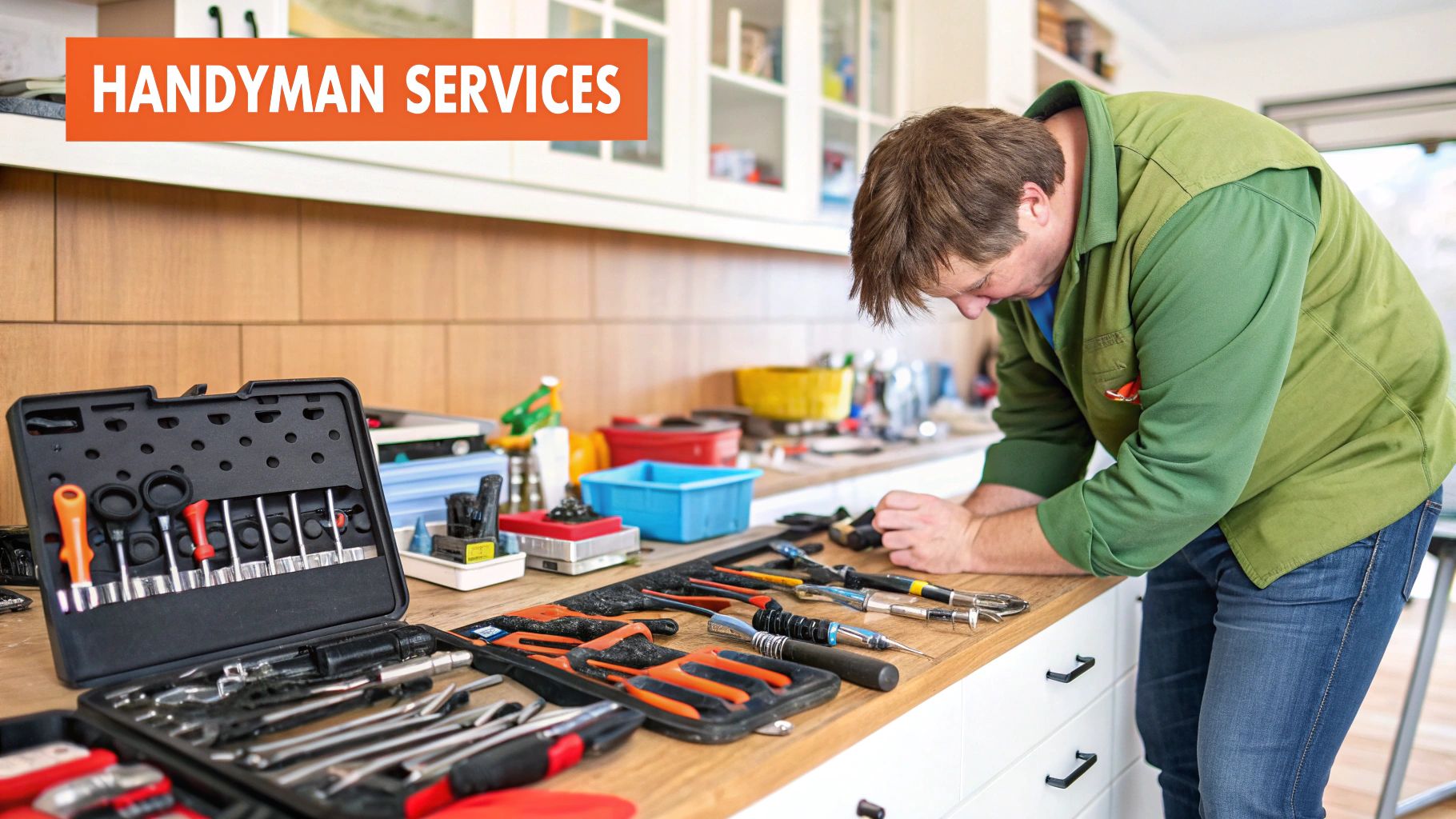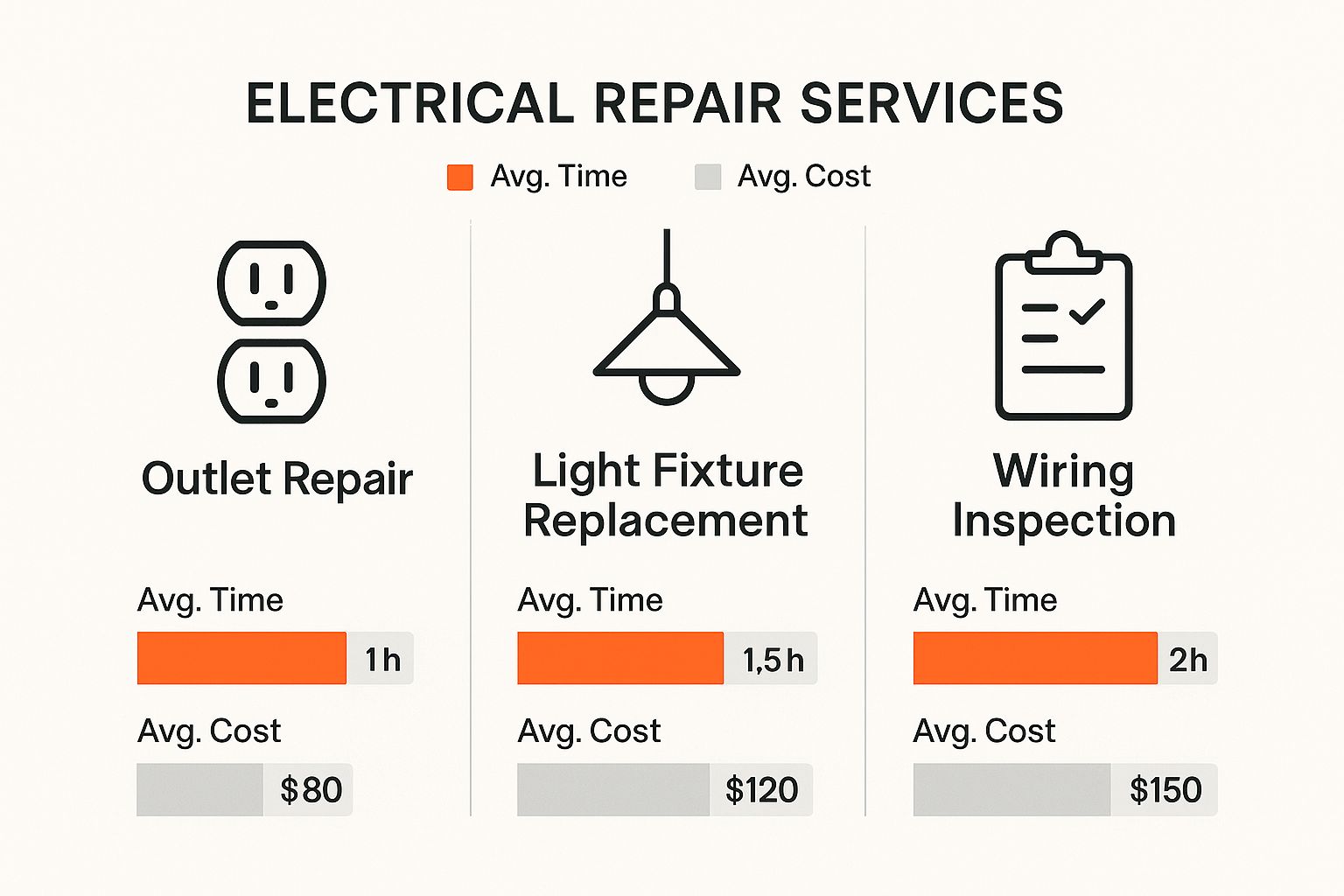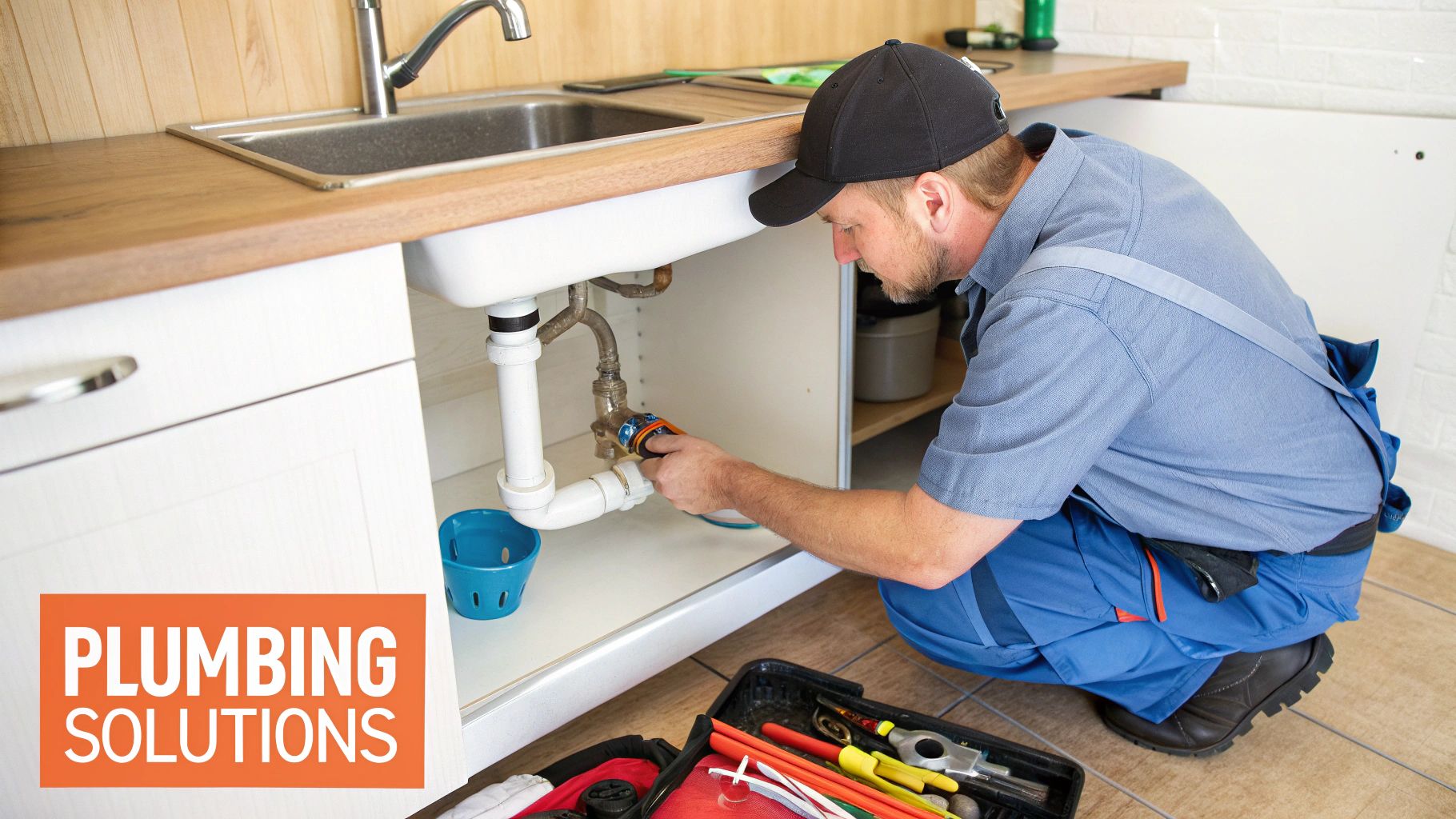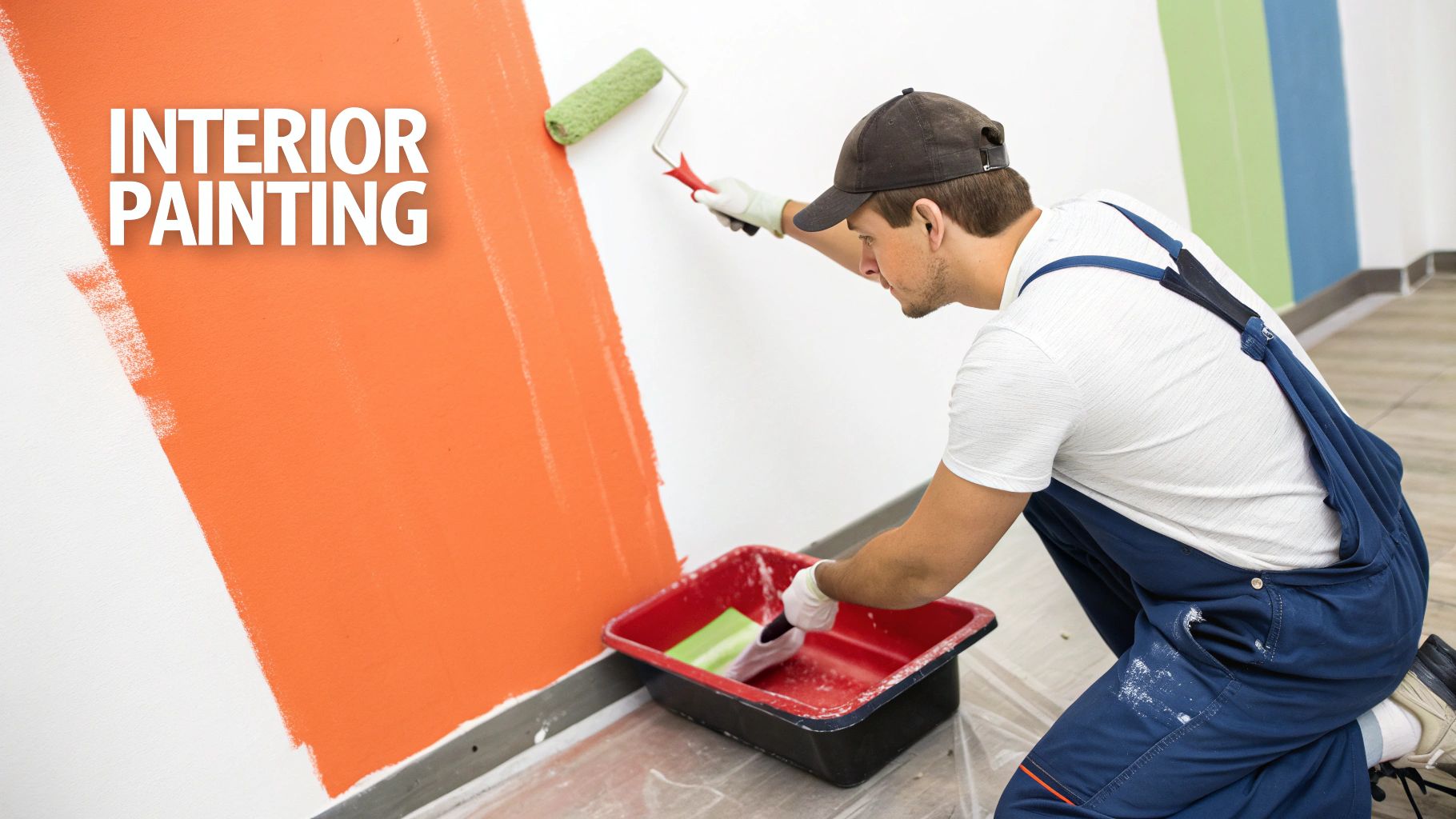-
CALL US:
- (866) 952-3456
That to-do list seems to have a life of its own, doesn't it? One minute it’s a few small items, the next it’s a novel-length saga of leaky faucets, squeaky doors, and pictures that need hanging. It's enough to turn your peaceful home into a source of constant, low-grade stress.
This is exactly where a professional handyman service comes in. It’s the perfect, practical solution to finally reclaim your weekends and your sanity. A good handyman is so much more than just a repair person; they're a versatile, experienced problem-solver for your entire home.

Think of a top-notch handyman as the Swiss Army knife for your property. They have a whole range of skills ready to go, perfect for tackling those small-to-medium-sized tasks that every homeowner runs into. We’re talking about things like patching a hole in the drywall, swapping out a light fixture, or finally assembling that flat-pack bookshelf that's been sitting in the box for weeks.
These are the kinds of jobs that are often too small to bring in a specialized contractor but are just a bit too complex or time-consuming for the average busy person to handle themselves.
Hiring the right pro isn’t just about getting a task checked off your list. It's about bringing in real expertise to make sure the job gets done right—and safely—the very first time.
This need for reliable home help isn't just in your head—it’s a massive, and growing, market. The sheer size of the industry shows just how many homeowners rely on these pros to keep their properties in good shape. As our houses get older and our lives get busier, that reliance is only going to increase.
By 2025, it's estimated that U.S. homeowners will spend an incredible $273.6 billion a year on handyman and home maintenance services. To meet that demand, there are roughly 522,800 handyman businesses operating across the country. That's a lot of professionals keeping our homes running smoothly! You can dive deeper into home improvement industry trends to see the data for yourself.
Hiring a handyman isn’t just an expense; it’s an investment in your property's value and your own well-being. You get your weekends back and the peace of mind that comes from knowing your home is in capable hands.
This guide is here to give you the confidence to navigate the world of home repair. We'll break down everything you need to know, from what a handyman actually does and how they price their work to how you can spot a true professional from the rest. By the time you're done reading, you'll be ready to conquer that to-do list for good.
Before you pick up the phone, it’s crucial to understand what a handyman is—and isn't. Think of a handyman as the Swiss Army knife of home repair. They're the versatile generalists you call for that growing "to-do" list of small but annoying problems that don't quite need a specialized contractor. Their real value is their broad skill set, letting them knock out a bunch of different tasks in a single visit.
Most of their work falls into a few key categories, which helps clarify when they're the right pro for the job.
This is the classic handyman territory. We're talking about all those little fixes that pop up and never seem to go away.
Ever buy a piece of flat-pack furniture, open the box, and feel instant regret? You're not alone. This is a perfect job to hand off.
Handymen are seasoned veterans when it comes to translating those famously confusing instruction manuals. They have the right tools and patience to assemble furniture, mount a TV securely on the wall, hang heavy mirrors, or install a new set of shelves. No sweat.
They can also handle a surprising number of minor plumbing headaches. From annoying drips to slow drains, many common kitchen faucet problems and their quick DIY fixes fall squarely within their skillset.

Knowing where a handyman's scope ends is just as important as knowing what they can do. This isn't just about experience—it's about safety, building codes, and keeping your insurance valid. Big jobs involving your home's core systems almost always require a licensed specialist like an electrician, plumber, or HVAC technician.
A good rule of thumb? If the job involves moving, adding, or significantly changing your home's structural, electrical, or plumbing systems, you need a specialist.
To make it crystal clear, let's break down where that line is typically drawn.
| Task Category | Ideal for Handyman Services | Requires a Licensed Specialist |
|---|---|---|
| Electrical | Replacing an existing light fixture, ceiling fan, or wall outlet. | Running new wiring, installing a new circuit, or upgrading an electrical panel. |
| Plumbing | Replacing a faucet, fixing a running toilet, or clearing a simple drain clog. | Rerouting plumbing pipes, installing a new water heater, or fixing a sewer line. |
| Structural | Repairing a fence, replacing a deck board, or fixing a broken stair tread. | Building a new deck, removing a wall, or any work on the home's foundation. |
| HVAC | Cleaning vents, replacing filters, or programming a smart thermostat. | Repairing or replacing a furnace, air conditioner, or ductwork. |
Trying to save a few bucks by having a handyman tackle a job that needs a license is a huge gamble. It can create serious safety hazards, lead to failed inspections, and could even give your insurance company a reason to deny a claim down the road.
By understanding this crucial boundary, you can hire with confidence, ensuring every job around your home is handled safely and correctly by the right professional.

Talking about money can feel a little awkward, but getting a handle on how home repair handyman services price their work is the best way to budget properly and dodge any nasty surprises. Think of it like a restaurant menu: some items are priced individually (hourly), while others are a set meal deal (flat-rate). Knowing the difference helps you figure out what makes sense for your project.
The most common approach is a simple hourly rate. You pay for the time the pro is actively working on your job. These rates can be all over the map, usually from $60 to over $125 per hour, based on where you live and the handyman’s skill level. This model is perfect for smaller jobs where the scope isn't totally clear or when you have a mixed bag of tasks to knock out.
On the other hand, many handymen offer flat-rate pricing for specific, well-defined jobs. You agree on one set price for the whole project, no matter how long it ends up taking. This is super common for standard tasks like installing a ceiling fan or putting together furniture, where a pro knows exactly what’s involved. For a closer look at how these costs break down, you can explore the factors that shape furniture assembly service costs, which often uses a similar flat-rate system.
The price you’re quoted isn't just a random number. A few key things come together to determine that final cost, and knowing what they are gives you a much better picture of what you’re paying for.
To make sure you're getting a fair shake, it's always smart to get estimates from two or three different pros. This isn't just about hunting for the cheapest price—it’s about finding the best value and the right person for your job.
When you ask for a quote, be as detailed as you possibly can. Snap some photos or even a quick video of the issue and type up a clear list of every single task you need done. This helps the handyman give you a much more accurate estimate right from the get-go.
A professional, transparent quote is a huge green flag. It should clearly break down labor costs, estimated material expenses, and any other potential fees, leaving no room for confusion down the road.
Once you have a few estimates in hand, compare them carefully. Be wary of a bid that's dramatically lower than the others. It could be a red flag for inexperience, a lack of insurance, or a sign that they plan to cut corners. A truly professional estimate will always be in writing and should include the handyman's contact info, a detailed scope of work, a cost breakdown, and an estimated timeline. This simple document protects both you and them.
Finding a truly skilled and reliable handyman can sometimes feel like searching for a needle in a haystack. With busy lifestyles and more people choosing to outsource home maintenance, the demand is definitely there. In fact, the global handyman market is on track to hit around $85 billion by 2025. You can read the full research about the growing handyman services market if you're curious about the trend.
With that many options out there, how do you find someone you can genuinely trust with your home? It really just comes down to a methodical approach—knowing where to look and, more importantly, what to ask.
Your quest for a great handyman should kick off with the people you already trust. There’s nothing more powerful than a word-of-mouth referral, because it comes with a built-in layer of confidence. A friend or neighbor has already taken the risk and can vouch for the quality of the work.
Okay, so you've got a few names. Now the real work begins. Vetting is hands-down the most crucial step in protecting your home and your wallet. Don't skip these checks, no matter how glowing a referral seems.
Think of this process like an open-book test; a real professional will have all the answers ready and will be happy to provide them.
A handyman who gets cagey or can't provide proof of insurance or references is an immediate red flag. Transparency is the hallmark of a pro who takes their business seriously.
Your goal is to confirm they're legitimate and skilled before they ever set foot on your property. This is where a simple checklist becomes your best friend. For a more detailed guide, our comprehensive contractor hiring checklist provides an excellent step-by-step resource.
Before you even start talking project details, there are a few non-negotiables you have to confirm. These steps are all about protecting you from liability and making sure you’re dealing with a legit business operator.
The core principles for vetting a handyman aren't all that different from how you'd choose a reliable home service contractor of any kind. Following these steps helps ensure you find someone who is not only skilled at what they do but also operates with integrity.

A great handyman visit doesn't just happen. It starts with a little prep work on your end, long before they even ring the doorbell.
Think of it like a chef needing a clean kitchen before they can start cooking. When you set the stage for your pro, they can walk in and get straight to the real work. That means you're not paying them to move your couch or clear off a counter. A few simple steps beforehand can make the whole process smoother, faster, and more productive for everyone.
The biggest thing you can do to help is to simply clear the area. A cluttered or hard-to-reach spot is a surefire way to add time and frustration to any job.
Before they arrive, just take a few minutes to:
This kind of prep isn't just for big jobs. As our guide on how to prepare for your furniture assembly project points out, these tips apply to almost any time you have a pro working in your home.
Beyond clearing the space, clear communication is your best friend. Your handyman can't read your mind, so giving them as much detail as possible is key to avoiding headaches later.
Start by making a simple, prioritized list of every task you need done. If you can, send this list to them ahead of time, along with some clear photos or even a quick video of the problem spots. That picture of the leaky faucet or the crack in the drywall speaks volumes.
A detailed task list with photos can turn a vague estimate into a solid quote. It helps the handyman show up with the right tools and a game plan already in mind.
This little bit of upfront effort means they come prepared, drastically cutting down the chances they'll have to make a second trip for a part they didn't know they needed.
The last piece of the puzzle is figuring out who buys the materials. There's no single right answer here; it really depends on the job and your comfort level.
Chat with your handyman about this beforehand to figure out the best plan for your project. A little preparation truly goes a long way in making sure your home repair handyman services experience is a five-star one.
The final handshake is just as important as the first one. Once the tools are packed up and the dust has settled, a few simple steps will ensure the job is truly finished and you’re thrilled with the result.
This isn't about being picky; it's about professional closure. A quick but thorough once-over confirms the work meets your expectations before you pay, which is the best way to prevent any future headaches or "I wish I'd noticed that earlier" moments.
Whatever you do, don't skip the final walkthrough. This is your moment to review everything with the handyman right there, ask questions, and see the repair in action. It's a hundred times easier to get a small adjustment made while they're still on-site than trying to get them to come back a week later.
A simple checklist can be your best friend here, just to make sure you don’t forget anything.
Think of the final walkthrough as your quality control checkpoint. It’s the moment to verify that the work you paid for was delivered to the standard you agreed upon, giving you total peace of mind.
Once you’ve given the work a thumbs-up, it’s time to settle up. Before handing over any money, always ask for a detailed, itemized invoice. This little piece of paper is your official record of the job.
A proper invoice should clearly show:
This level of detail is a sign of a professional operation and makes it crystal clear what you're paying for. If you want a better sense of how these costs are calculated, it helps to understand typical handyman pricing structures and what’s usually included.
What if something isn't right? If the work doesn't meet your expectations, bring it up calmly and specifically during the walkthrough. Refer back to your initial agreement to clarify what was supposed to be done. A reputable handyman wants you to be a happy customer and will almost always be willing to make it right.
https://www.youtube.com/embed/xnbuy82P_lM
Diving into the world of home repair handyman services can definitely stir up a few questions. Getting straight answers is the best way to feel good about who you're hiring to work on your home. Let's walk through some of the most common things homeowners ask.
Knowing what to expect from the get-go makes the whole process smoother. Any pro worth their salt should be able to give you a clear idea of how the job will unfold.
It really comes down to the job itself and what you're comfortable with. For anything happening inside your home, most people prefer to be there, at least when the work starts and finishes. This way, you can let them in, clear up any quick questions, and do a final walkthrough when they're done.
But if you've worked with the handyman before and trust them, or if the job is completely outside—think fence mending or cleaning out the gutters—you might not need to hang around the whole time. The key in these situations is crystal-clear communication about how they'll get access to the property and how they'll keep you updated.
While it’s always a welcome gesture for a job well done, tipping isn't really a standard expectation for a handyman. Unlike a waiter, a handyman sets their own rates to make sure they're being paid fairly for their skills and time.
That said, if you're absolutely thrilled with the result, they went the extra mile, or they handled a tough situation like a true pro, a tip is a fantastic way to say thanks. Another powerful way to show your appreciation, and one that often helps their business even more, is to leave them a glowing online review.
Remember, the best "tip" you can give a great handyman is repeat business and referrals to your friends and family. This kind of trust is the foundation of their small business's success.
A reputable handyman will almost always stand behind their work with some sort of guarantee. It might not be a formal, printed warranty, but more of a professional promise that they do quality work. This is a super important question to ask before you hire them.
Most will offer to come back and fix anything that goes wrong because of their labor within a reasonable period, like 30 to 90 days. This usually doesn't cover the parts or materials themselves, as those are typically covered by the manufacturer's warranty. Always get clarity on their workmanship guarantee before work starts so you're both on the same page and your investment is protected.
When that to-do list just keeps growing, whether it's putting together that new bookshelf or knocking out other small projects, professional help is just a click away. Let Assembly Smart take the hassle off your hands with our expert, reliable service.
Book your stress-free appointment today at https://assemblysmart.com and get your home in perfect order.